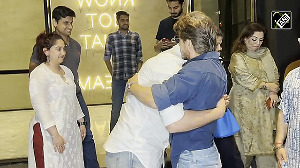What are the benefits of representing India in the national cricket team? It is an opportunity to compete with the best in the world and pitch one's talent against the best.
It is an opportunity to travel around the world. It is an opportunity to uphold national pride. And make good money from every match played.
But there is more -- a ticket to modelling in the advertising world (and a future perhaps in Bollywood). Not surprisingly it's a very attractive profession.
As advertisers pour crores of rupees every year into celebrity advertising, the question arises is it worth all the money and the headaches of coordinating stars and managing their tantrums.
Think of Sachin Tendulkar. He means Pepsi in soft drinks, Boost in malted beverages, MRF in tyres, Fiat Palio in cars, TVS Victor in two-wheelers, Colgate Total in toothpastes, Britannia in biscuits, Visa in credit cards, Airtel in mobile services and Band-aid.
Clearly, an overload of brands and categories associated with one star.
Does it actually help each of the brands? Does the consumer think in categories and slot brands accordingly or is it one big maze of brands and saliency is dependent on 'recency.'
Interestingly, while celebrity advertising is big, few agencies actually present celebrity advertising as a solution to client problems.
In the advertising world, celebrity advertising is seen as a substitute for 'absence of ideas' -- and actually frowned upon. Yet it appears again and again.
The reasons are quite insightful.
A client hits upon celebrity as a solution when his agency is unable to present to him a viable, exciting solution for his communication/marketing problem. He then feels that the presence of a well-known face is an easy way out.
A client looks at a celebrity solution, sometimes, to follow competition. When attacked with a celebrity, a quick response is to get another one to combat. The result is often, at best, achieving parity.
A third, and often unfortunate, reason for celebrities is a client's desire to rub shoulders with the glitterati. And signing a celebrity is a passport to that. Most frequently, celebrities are given as 'fate accompli' to the agency. And scripts are written around them.
It is rare that there is an idea on the table and client and agency mutually agree that the presence of a celebrity will actually lift the script. This is very similar to Bollywood blockbuster films where the cast is decided upon and the script either written accordingly or re-engineered around the cast!
There is no doubt that celebrity advertising has its benefits -- the four Qs:
Quick saliency: It gets cut through because of the star and his attention getting value. Goodlass Nerolac has ensured high saliency for its brand with the inclusion of Amitabh Bachchan in its advertising.
Quick connect: There needs to be no insight but the communication connects because the star connects. Sachin, Shah Rukh and their ilk's ensure an easy connect for Pepsi with the youth.
Quick shorthand for brand values: The right star can actually telegraph a brand message fast without elaborate story telling. Kapil Dev and Sachin Tendulkar seem to have done that successfully for Boost in the early '90s. And helped to differentiate it in the malted beverages market.
Quick means of brand differentiation: In a category where no brand is using a celebrity, the first that picks one up could use it to differentiate itself in the market. Boost did it in the malted beverage category.
And Preity Zinta does all the above four for Perk -- connecting with the youth and reinforcing the brand's youthful, spontaneous, energetic values.
There are however the classic fears of celebrity usage.
The celebrity vampires the product: Unless the celebrity's values, the category benefit and the brand values are closely linked, there are chances that the celebrity is remembered more than the brand he is advertising for.
And in a celebrity clutter, the chances that the brand and category can be remembered become even more difficult for the average consumer. Pepsi and Lux tend to use multiple celebrities in an attempt to overcome this.
The celebrity trap: Once into a celebrity, it is hard to get out of it. If the brand has done even moderately well after the break of a celebrity campaign, it becomes difficult to separate the role of message and the role of the celebrity in selling the brand.
And hence, the celebrity becomes an addiction for the marketing team.
And the task to find substitutes becomes more and more difficult. Interestingly, celebrity is a disease that is seen to spread across a marketing department. Once one brand manager gets into it, others tend to follow, not wanting to be left behind!
With the surfeit of celebrities on screen and in the newspapers, there are two new drawbacks emerging for celebrity usage.
Celebrity credibility is coming under question. Consumers are getting more and more advertising savvy and are beginning to voice opinions, even in small towns, like "He has been paid to sell the product."
Clearly celebrity endorsement is no longer as credible as it was a few decades ago.
Unless category and celebrity are closely linked (like Nike and sports stars), the power of a celebrity's word is questionable.
The trustworthiness of public figures, which celebrities tended to bring in the past, is bound to disappear if a celebrity begins to appear and endorse a brand in every conceivable category!
Celebrity clutter. With each celebrity endorsing multiple products and multi brands in a category, resorting to different celebrities, the consumer is left confused.
And reluctant to get into 'this celebrity is bigger than that comparison' to make brand choices.
Santro is endorsed by Shah Rukh Khan and Palio by Sachin Tendulkar does the consumer buy the brands because of the star pull? a question worth pondering about. It ends up making brand parity rather than giving brand differentiation, often one of the key aims of using a celebrity.
When Palmolive used Kapil Dev in the '80s, his line 'Palmolive da jawaab nahin' became famous -- it is remembered even today.
Pataudi gave Gwalior suitings a strong competitive edge and pushed it to Number 2 in perceptions in the suitings market.
Even Sridevi made Cema bulbs and tubes memorable by dancing in a bulb!
The advertisements by themselves were fairly non-descript; the celebrities gave the brand the differentiation. Celebrity advertising were few and far in between in those days. The days of 'pure' celebrity working for the brand seem to be over.
Today, it is back to the power of an idea and an insight. No simple solutions exist any longer. Unless there is something powerful in the idea, the celebrity is just another cost.
Aamir Khan and Coke is the ultimate example of the same. As long as the brand depended on his star value and wove interesting stories around him, it just didn't cut ice with the consumer -- until 'Thanda Matlab Coca-Cola' happened.
Could it have worked as well without a celebrity? One will never know as the brand has entered the celebrity trap.
Something worth thinking about.
The writer is Country Manager - Discovery, Ogilvy and Mather India.






 © 2025
© 2025